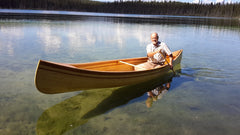To Keel or Not to Keel?

There's no straight answer to whether you should put a keel on your canoe - that's an area largely determined by personal preference and intended use. However, if you're on the fence, the ever-reliable Ron Frenette of Canadian Canoes has some advice that might make the decision easier.
Here's Ron's reply to a customer wondering about keels:
"Keels always draw a bit if discussion as in: Do I need/want a keel? What are the benefits/drawbacks from having or not having one? Should I have a thinner ‘shoe’ keel to protect the hull or a deeper ‘lake’ keel to cause drag if the wind is blowing my canoe sideways?
Many years ago, we recognized that individual customers would have a variety of responses to the question, ‘To keel or not to keel?” Thus, we decided to make all our hulls WITHOUT any keel. This caused us to then shape the outer stem in such a way that it flowed into the hull; no part was standing above the hull.
Once the hull of the canoe has been covered with the fibreglass cloth and epoxy resin, the builder has choices.
(1) S/he can elect to keep the hull ‘keel free’ which allows wonderful lateral motion but leaves the bottom vulnerable to rock damage.
The same builder might decide, after 2 months or 2 years to add a keel - not a problem.
(2) This hypothetical builder could decide from the outset to complete the build with a keel (shoe or lake as described above) and that makes the keel pretty much permanent.
(3) ou will build the entire hull, glass it outside and inside and will have added at least the inner gunwales to ‘stiffen’ the hull.
At that juncture, you will add on your shoe keel!
You could also ‘show off’ a bit and use temporary steel screws (not those we supplied) - well waxed - and install the keel as described.
After 24 hours, remove the screws and cup washers. Gently drill a ¼” hole in the hull where the screws were located. Now, get a length of ¼” dowel, cut a series of 5/8” lengths and epoxy these little pegs into those holes.
Another 24 hours later, you can flush cut the little ends sticking above the hull and sand smooth. Now, your keel is firmly in place with no fasteners showing.
Hope this helps and feel free to ask questions should they arise.
Regards,
Ron Frenette"
Thanks again to Ron for sharing his expertise!

